
29.11.2019
Bereits im Mai sorgte der erste SpaceX-Falcon9 Start mit 60 Starlink-Satelliten für Meldungen bei unserer UFO-Meldestelle und wir hofften jetzt beim zweiten Start vor ein paar Tagen es hier vielleicht zu schlechtes Wetter gäbe für Beobachtungen. Hier im Süden war zumindest am frühen Morgen die Reste eines Regengebietes und so waren wir dann doch etwas erstaunt aus dem Norden zwei Meldungen zu bekommen welche wir auf die Starlink-Satelliten zurückführen konnten.
CENAP-Michelstadt
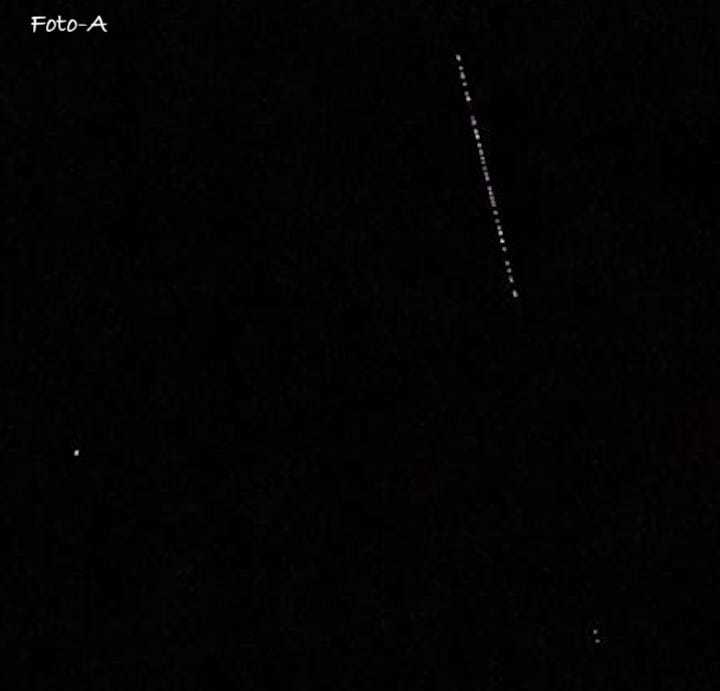
CENAP-Archiv: Foto von Spacelink-Satellitenkette vom 25.05.2019
Die erste Meldung bekamen wir per SMS-Nachricht um 8.26 Uhr:
Sichtung: Lichterketten/Perlenschnur oder Satellitenkette, 30-40 Objekte, sehr hoch, aus SSW, Richtung NO, gegen 6.00 Uhr heute Morgen über 14715 Milower-Land, ohne Geräusche...
Gruss, H.G.

Karte: Milower Land

+++
Die zweite Meldung erreichte uns aus 23617 Krumbeck per E-Mail:
Guten Morgen
Heute Morgen gegen 06.45 Uhr habe ich eine ungewöhliche Beobachtung am Himmel
Gemacht. Ich weiß nicht wie ich das so wirklich beschreiben soll. Erst dachte ich es wären
Satelliten aber das kann nicht sein und für Wetterballons waren diese Lichter zu hoch. Es
waren so circa 32 Lichter in bestimmten Abständen wie auf einer Perlenkette aufgereiht die
hintereinander flogen. Sie flogen von Ost nach West, meine Trassee ist Richtung Süden
ausgelegt. Diese Lichter waren deutlich zu sehen. Von der Farbe wie ein Stern den man
sehr gut sehen kann. Bevor die letzten nicht mehr sichtbar waren kamen noch 6 bis 7 in
größeren Abständen hinterher .Die ganze Beobachtung dauerte ungefähr 20 Minuten.
Satelliten sieht man ja öfters mal aber diese Lichter waren etwas langsamer.Ich konnte Sie
solange beobachten bis diese nicht mehr sichtbar waren.
Habe Sie eine Erklärung dafür?
mit freudl. Gruß
J.Z.

Karte Krumbeck
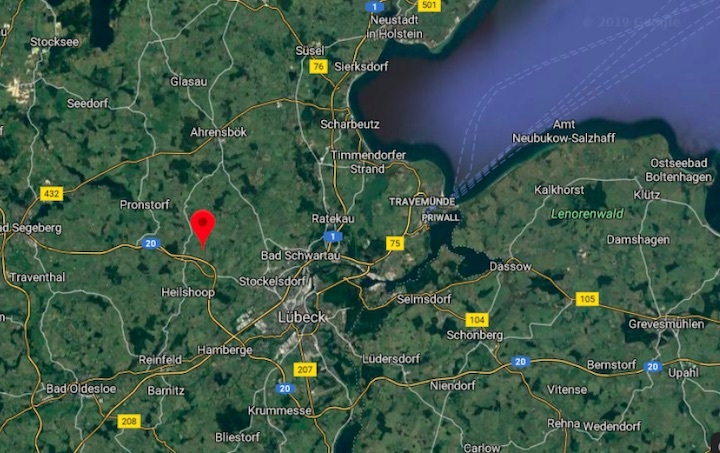
-
Die nächsten Tage sind diese Starlink-Satelliten am frühen Morgen bei klarer Witterung gut zu sehen und trumpfen am Sonntagmorgen mit über 6mag ordentlich auf. Sie werden dann nachfolgende Tage wieder schwächer um 3mag, wie sie auch am heutigen Morgen wahrgenommen werden konnten.
Blick auf die Überflüge:

+++

Quelle: HEAVENS ABOVE
----
Update: 2.12.2019
.

Weitere Beobachtungen der Starlink-Satelliten erreichten uns über Tel-Anrufe und E-Mail aus:
Kalkhorst, Vitense, Boltenhagen, Stendal.
Wieweit uns zukünftig diese Starlinks beschäftigen werden ist abzusehen, da dieses Satelliten-Netz weiter ausgebaut wird und unsere astronomischen Kollegen weltweit alarmiert und besorgt.
CENAP-Michelstadt
Interessanter Beitrag hierzu aktuell:
...
Losing the night: Astronomers concerned about too many satellites lighting up the sky
SpaceX alone could launch more than 30,000 satellites into orbit

This image is composed of 300 short, 13-second exposures taken within 70 minutes from Waldenburg, Germany, on the night of the Perseids meteor shower in August 2018, before the launch of 120 Starlink satellites. Most of the noticeable lines are made from satellites reflecting sunlight from below the horizon.(Eckhard Slawik)
On the night of Nov. 18, Cliff Johnson, an astronomy researcher at Northwestern University, was using the Dark Energy Camera on a telescope at the Cerro Tololo Inter-American Observatory in Chile to search for nearby dwarf galaxies.
In order to capture the light of faint, distant objects, the camera needs to take long-exposure images.
At first, Johnson noticed the streak of a meteor in one image. And then a plane. Nothing unusual. But then he noticed a train of long, seemingly inexplicable streaks.
"At first, I was just trying to figure out, 'What is this?' And then I put two and two together and thought, 'Oh right, this is probably Starlink," said Johnson. "And it was the predicted orbit for that whole train."


Johnson's observing run had been photobombed by SpaceX's 60 Starlink satellites, launched as part of the company's lofty goal to provide internet service to every part of the world.
This was the second launch of 60 Starlink satellites. But the 120 satellites now in orbit is really just a drop in the bucket: The company has permission to launch 12,000 satellites in total — and has asked to launch 30,000 more.
That would be roughly eight times more than are already in orbit.
It has astronomers deeply concerned.
Astronomical community reacts
All satellites have reflective surfaces, including a solar panel. When sunlight reflects off them, they shine periodically in the night sky.
While SpaceX's Starlink network currently stands as the most ambitious — and plentiful — satellite constellation, it isn't the only one.
Amazon plans to launch more than 3,000 of it own satellites; Boeing has applied for anywhere between 1,396 and 2,956; and even Canada has committed to launching close to 300 Telesat satellites.
Following the first Starlink launch in May, astronomers were shocked at just how visible their train of lights were. While over time the satellites would reach a higher altitude, reducing the brightness, astronomical organizations were quick to respond.
Watch: Marco Langbroek's footage of the Starlink satellites launched in May from Leiden, the Netherlands.
The International Dark-Sky Association (IDA), a non-profit organization dedicated to protecting the night sky, released a statement: "The number of low Earth orbit satellites planned to launch in the next half-decade has the potential to fundamentally shift the nature of our experience of the night sky. IDA is concerned about the impacts of further development and regulatory launch approval of these satellites."
The International Astronomical Union (IAU) and the American Astronomical Society (AAS) also weighed in with statements of their own.
But so too did SpaceX CEO Elon Musk: he promised to look into the reflectivity of the satellites, known as albedo.

Nothing new
Satellite constellations aren't anything new; they've been around for decades. (The GPS in your devices work using such a constellation). However, these networks were typically made up of dozens of satellites — not thousands.
And they've never affected astronomers quite like the Starlink network has.
"It was pretty unlucky, I think, that we happened to be pointing … right where the train came across," said Johnson. "It was pretty shocking to see the entire train come across in our webcam view and later see the trails on the image that we took."
As a result, at least part of that imaging run will have some data lost.
"It isn't great for us, but there are ways to try to get around it," said Johnson.
Still, he is concerned by the overall trend.
"This is just the beginning; this is after two sets of satellites. And this is going to become a much more frequent incident."
Billion-dollar threat
At a time when more large-scale telescopes are being built, the potential of building constellations consisting of tens of thousands of satellites could jeopardize not just a hobby, but astronomical organizations probing the depths of our universe.

One such telescope is the Large Synoptic Survey Telescope (LSST), a $1 billion, 8.4-metre, ground-based telescope currently under construction in Cerro Pachón, Chile. Once completed in 2020, it will become the most important wide-field imager ever built, helping astronomers better understand galaxy formation, dark matter and more.
But if there are 30,000 satellites streaking through its data, it could seriously threaten research.
Jeff Hall, an astronomer at Lowell Observatory in Flagstaff, Ariz., and the chair for the American Astronomical Society's Committee on Light Pollution, Radio Interference, and Space Debris, said he and others from the AAS are currently trying to assess the impact on professional astronomy. They are currently engaged in discussions with SpaceX.
While there have been suggestions to reduce the satellites' albedo by painting them black, it's not that simple: black absorbs light and could damage the satellites' sensitive instruments.
When it comes to regulating an increasingly crowded Earth orbit, Hall says it'll have to be an international effort, to ensure that everyone gets on board with set global standards. But is it already too late?
"You could probably make an argument that, yeah, the train has left the station," said Hall. "But my feeling is, the situation is what it is — and you just work with the reality and work with that the best that you can."
Mary Beth Laychak, outreach program manager at Canada-France-Hawaii Telescope, isn't only concerned about optical telescopes, but also those working with other wavelengths.
"While a lot of the focus has been on the impact for optical astronomy, I know astronomers who work in the submillimeter and radio wavelengths that are very concerned about the impact on their work," she said in an email. "The satellites broadcast in the wavelengths that high-frequency radio telescopes are sensitive to."
In an email statement to CBC News, SpaceX said it is co-ordinating with the National Radio Astronomy Observatory to work toward a solution. The company said it is also working with astronomical organizations around the world to ensure the impact to their work is minimally affected.
In the meantime, SpaceX is set to launch another 60 satellites next month.
"I think the goals that SpaceX lays out, of providing internet access to underserved areas — that's a worthwhile goal," said Hall. "It's just that it caught us by surprise. I think it caught SpaceX by surprise."
Quelle: CBC News
+++
No, these aren't UFOs, but here's how you can try to spot them
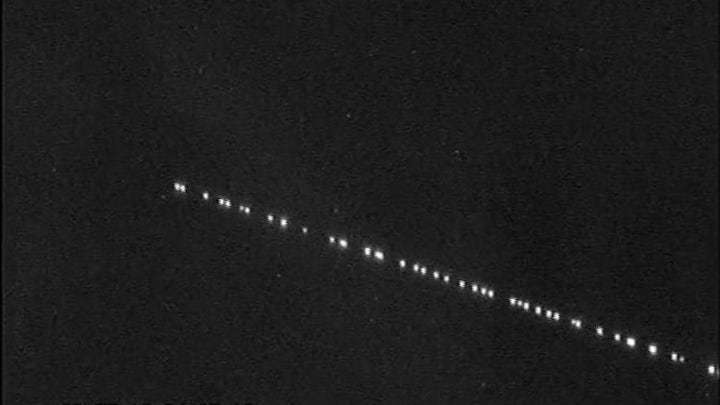
Last week, SpaceX launched 60 satellites into space atop its Falcon 9 rocket. Less than a day later, astronomers captured their amazing trail of lights as they crossed the sky.
They are part of a project called Starlink, which will eventually comprise 12,000 satellites whose goal is to provide much-improved internet access to every part of the world.
Marco Langbroek, an archeologist and spy satellite consultant based in the Netherlands, was stunned when he managed to record the satellites' path using a low-light surveillance camera on May 24, 22 hours after their launch.
Watch: Marco Langbroek's footage of the satellites from Leiden, the Netherlands.
"It started with two faint, flashing objects moving into the field of view," Langbroek wrote on his blog. "Then, a few tens of seconds later, my jaw dropped as the "train" entered the field of view. I could not help shouting "OAAAAAH!!!!" (followed by a few expletives ...)"
The trail was visible from Canada, too.
Amateur astronomer Randy Dodge happened to catch it from roughly 75 kilometres west of St. John's, at around 10 p.m. ET on May 24.
"We had just finished an observing event for 'Becoming Outdoor Women' and other campers at the Salmonier Nature Park, when people started shouting and pointing to this unbelievable object passing from west to east," Dodge said. "It was a chain of lights with trailing lights, taking about three minutes to pass."
John Peddle and his wife, Andrea, also saw them in the sky above Torbay, Nfld., that same night.
"At first I thought it was the trail from a jet, but it seemed too bright for that time of the night," he said. "I looked at it through the binoculars I had with me and saw it was actually dozens of lights. At first, I thought it was a meteor or [piece] of space junk burning up, but quickly noticed the lights were moving way too uniformly for it to be that."
The satellites were at roughly 440 kilometres in altitude — slightly higher than the International Space Station. Over the coming days, as they orbit, they will rise to 550 kilometres.
There's still a chance you could spot them, too. The keys are dark skies, patience and binoculars.
How to see them
First, you need to understand about visual magnitude. Astronomers have come up with a way of measuring the brightness of objects in the night sky.
The brightness of celestial objects is on a scale that goes from the very brightest — the sun — to the dimmest. And the lower the number (negative values), the brighter the object.
As you can see by the chart above, the visual magnitude limitation for the human eye is an object with a magnitude of +6, and that's in dark-sky locations, away from the pollution of city lights. Within a city, that drops to +3.
The brightness of the Starlink satellites over Toronto, for example, range from roughly +6 to +3, right on the visual limit in light-polluted skies.
So, if you want to see the satellites — which will have spread out a bit more by now — get to a dark-sky location, away from city lights. They won't be as bright as in Langbroek's video, since he captured them with a low-light camera.
Clark Muir, an amateur astronomer from Kitchener, Ont., has some good news for anyone stuck in an urban area who is still hoping to spot the satellites.
"I counted a train of 20 satellites passing by from the urban skies of Kitchener. The eighth satellite in the train was by far the brightest at probably third magnitude. The rest were generally fifth magnitude," he said. "The bright one was easily seen without optical aid from my light-polluted location. Binoculars proved best to observe and count the rest."
There are a few ways you can determine when and where to look. A user-friendly resource is Heavens-Above.com (there's an Android app available). If you enter your location, it will give you a list of the times of the leading and trailing Starlink satellite, and if you click on the date, it will provide a sky chart with the constellations and a line indicating where the satellites will cross the sky.
It's better to print out the map rather than read it on your phone, since the light from the device will make it more difficult to see dimmer objects in the sky. Hold the printed map over your head and ensure you've got the directions correct — south on the map is south in the sky. The arrow illustrates the direction the satellites are moving.
There is also N2YO.com ("Watch Starlink satellites crossing your sky!" is at the top of the page) and CalSky.com, where you can find instructions under "Current topics." Both will automatically detect your location once you click their link.
Not everyone is happy
Though a spectacular sight in the night sky, not everyone is happy about the Starlink satellites. They are aimed at providing improved access to the internet worldwide, but some astronomers are concerned about the possible consequences of having 12,000 more satellites in an already crowded Earth orbit.
SpaceX founder Elon Musk tweeted that the aerospace company was ensuring that there would be "no material effects on astronomy," and that his Starlink team was looking at reducing the reflectivity of the satellites. However, he did not provide details.
Quelle: CBC News
----
Update: 3.12.2019 / 8.45 MEZ
.

Weitere Meldungen über die Starlink Satelliten "Perlenkette" gingen bei unserer Meldestelle heutemorgen ein:
Niedergörsdorf, Berlin-Lichtenfelde, Torgelow
CENAP-Michelstadt
+++
22.00 MEZ
Weitere Meldungen über die Starlink Satelliten "Perlenkette" gingen bei unserer Meldestelle am Abend ein welche ebenfalls heutemorgen beobachtet wurden:
Genthin: "Perlenschnur ähnliche Sternenspur", bei Möckern auf Landstraße, Treuenbrietzen,
CENAP-Michelstadt
----
Update: 4.12.2019
.

Auch heutemorgen gingen wieder Beobachtungen der Starlink-Satelliten über unsere Telefon-Hotline ein:
Sonsbeck, Willich, Mühlheim/Ruhr
+++
Winterbach bei Stuttgart, Südlohn/Borken, Nürtingen/Zizishausen, Dresden
+++
Weitere Beobachtungen gingen im Laufe des Nachmittags und Abends über E-Mail und Kontaktformular ein:
Neuffen, Hohenstadt, Großbottwar, Zedlitz, Bad Düben, Lehrte,
CENAP-Michelstadt
+++
Der erste Zeitungsbericht darüber welcher seine Leser aufklärt um "die seltsamen Perlenketten" erschien in der Berliner BZ:
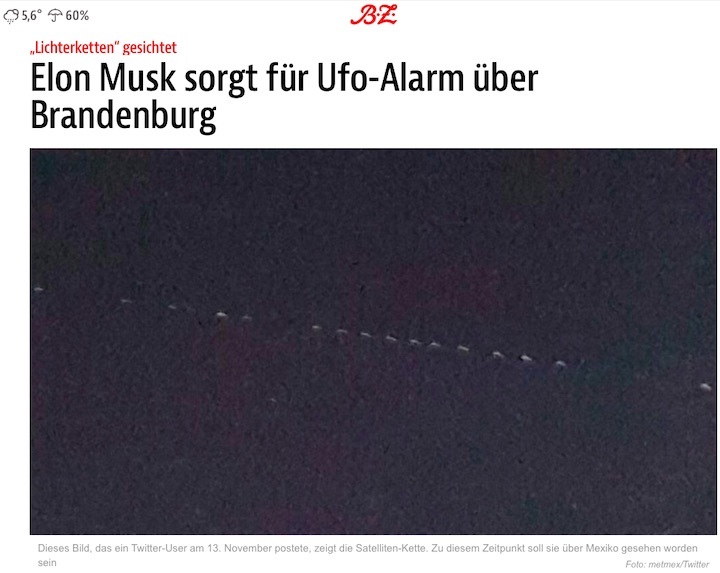




Quelle: BZ
+++






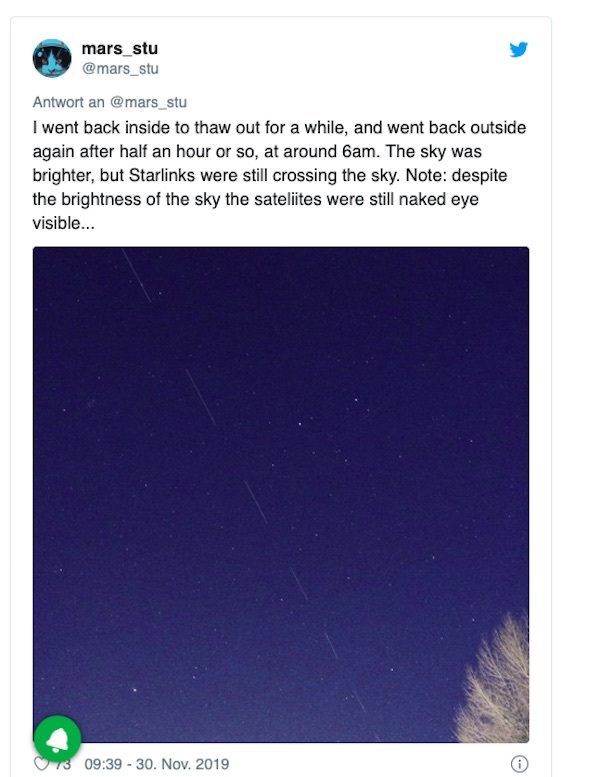




Quelle: Frankfurter Rundschau
----
Update: 5.12.2019
.

Und weiter geht die Meldewelle von Starlink-Satelliten bei unserer Meldestelle am frühen Morgen. Einmal wurden sie gegen 5.10 Uhr und beim zweiten Überflug gegen 6.42 Uhr beobachtet und hier fast zeitgleich gemeldet. Insgesamt gingen heute 15 Meldungen ein (Stand 11.30MEZ).
Meldungen kamen aus:
Harburg-Wilstorf, Berlin-Mittenwalde, Berlin-Ludwigsfelde, Werder-Havel, Wolmirstedt, Einbeck, Oelde,
Papenburg, Brilon, Bad-Nauheim, Bruchhausen-Vilsen, Hammelburg, Bad Mergentheim
+++
Aus Schmachtenhagen bekamen wir diese Handy-Aufnahmen von den Starlink-Satelliten:

+++
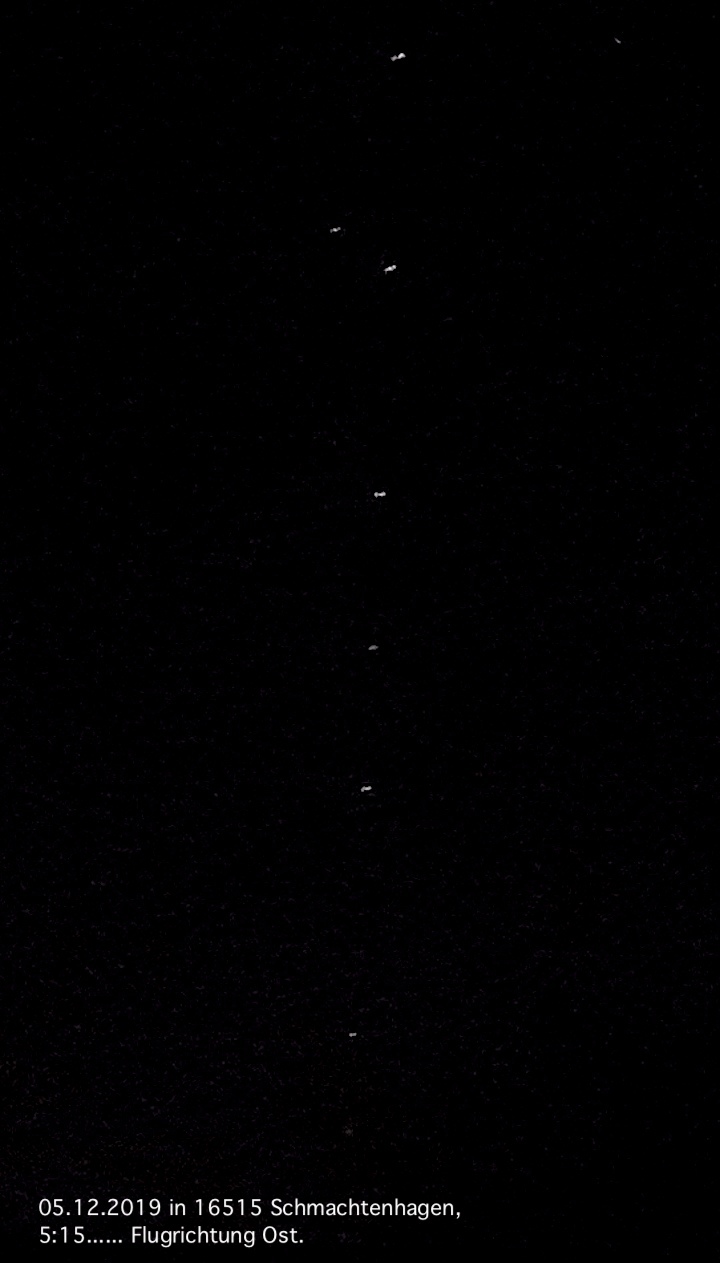
+++
Nachfolgende WhatsApp-Nachricht bekamen wir mit Skizze aus 58706 Menden:
Guten Tag mein Name ist C.H. und ich habe heute morgen, als ich mein Auto vom Eis befreite, UFOs gesehen, wie auf der Zeichnung beschrieben. Nun, sie leuchteten wie Sterne am Himmel und ich war überrascht das sie sich bewegten und dann nahm ich die Formation wahr. Zwischen den Punkten war ein handgreiflicher Abstand ohne Daumen, bei ausgestreckten Arm, schwer zu sagen wie hoch. Ich habe 15 gezählt wobei noch mehr auftauchten. Ich musste die Beobachtung einstellen, da ich zur Arbeit fahren musste. Ich beobachte gerne die Sterne und schaute nach oben und sah den großen Wagen, dabei nahm ich Bewegung wahr, schaute genauer hin und sah dann diese Formation. Uhrzeit 0642 uhr.
Beobachter-Skizze:

+++
Siehe auch Background zu Starlink-Satelliten hier:
CENAP-Michelstadt
+++
18.00 MEZ
Weitere Meldungen erreichten uns am Nachmittag/Abend über Telefon aus:
Fischbachau: Beobachtungen am 4.12./6.20MEZ und 5.12./6.45MEZ, Ingolstadt, Hamburg-Wentorf,
CENAP-Michelstadt
+++
Da wir morgen in Süddeutschland noch einmal klare Wetterlage haben nachfolgend die Überflugdaten der Starlink-Satelliten für den 6. Dezember:
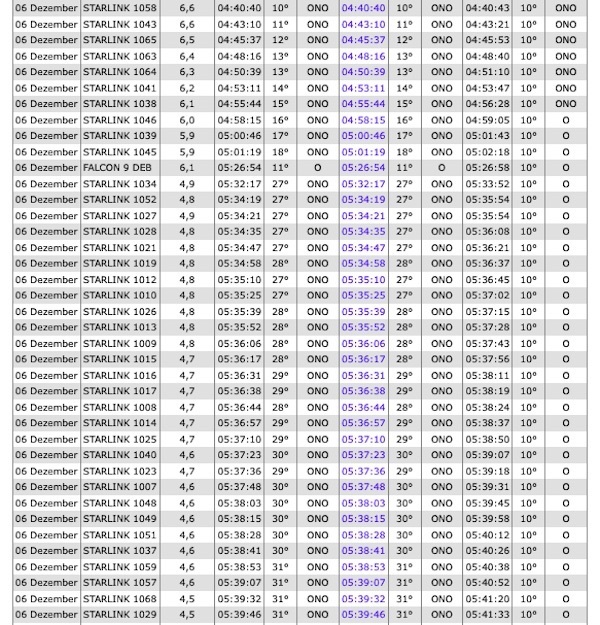


Quelle: Heavens Above
----
Update: 6.12.2019
.

Weitere Meldungen vom 5.12. von den Starlink-Satelliten welche in den letzten Stunden per E-Mail nachgereicht wurden an unsere Meldestelle:
Sehr geehrter Herr Köhler,
anbei erhalten Sie unsere heutige Beobachtung.
1. Ort der Beobachtung (mit PLZ, ggf. auch Ortsteil und/oder Straße)
XXXXXXXXX
89150 Feldstetten
2. Datum und Uhrzeit der Beobachtung
5.12.19 6:40-6.52
3. Dauer der gesamten Beobachtung
10 Minuten
4. Wie sah das „Phänomen” aus (Form, Farbe,Lichter)
Wie Satelliten bzw. schwach leuchtende Sterne, nur ungewöhnlich viele. Ca 11 Stück auf
einmal zu sehen. Es waren aber mehrere Dutzend im Zeitraum von 10 Minuten.
5. Wie bewegte sich das „Phänomen” (Flugverhalten)
Wie Satelliten in der Umlaufbahn, einige Objekte waren schneller.
6. Evtl. Geräusche
Nein
7. In welcher Richtung tauchte das „Phänomen” auf und in welche Richtung verschwand es
(Himmelsrichtungen falls bekannt, ansonsten Richtung xyz-Ortsteil, xyz-Straße o. ä.)
Vom Westen zwischen Westerheim und Zainingen. Im Osten zwischen Laichingen und
Herolstadt.
8. Wie verschwand das „Phänomen”
Alle gleichmäßig im Horizont
9. Ggf. weitere Augenzeugen2. Datum und Uhrzeit der Beobachtung
Meine Frau
Vielen Dank und viele Grüße
B.B.
05.12.2019 23:31
Ungewöhnlich viele Satelliten über Laichingen
+++
Datum : 05.12.2019 Uhr : 06:45 Ort : Hildesheim.

Ich bin gestern morgens aufgestanden und Parkplatz gesucht für mein Auto dann habe
ich Auto geparkt, und wollte zu Hause gehen, habe Himmel gesehen viele Ufos auf
einander gleiche Linie fliegen, habe Schock gekriegt die sind kann nicht Flugzeuge sein,
sofor zu Hause gelaufen und Handy genommen kurz Video gemacht aber leider
Kamera ist schwach 20 Sekunden nur schwarz Bild :( die waren mehr als 30 Stück. Und
waren ca. 15 tauschen fit fliegen. Ich mag die Sterne gucken, bis jetzt habe ich nie
gesehen, die haben ost/nord Seite geflogen. Ich wollte nur Bescheid geben, vielleicht
jemanden auch gesehen.
Die sind so aussieht; https://youtu.be/8OrmD1TP0N4

Nach ansehen des Video als Vergleich, handelte es sich hier um LED-Ballons welche ihre Position zueinander zum Beobachter verschieben.
+++
Weitere Beobachtungen erreichten uns für den 6.12. per Telefon und Kontaktformular aus:
Rosenheim-Stadtauswärts, Kusterdingen, Albstadt, Baienfurt, Markt-Rettenbach, Schmiechen, Wartenberg, Eggenfelde
+++
Update: 20.00 MEZ
Nachricht: => Hallo Herr Köhler!
Ich wende mich an Sie ,weil ich eine Beobachtung gemacht habe ,welche mich schon den ganzen Tag beschäftigt.
folgender Sachverhalt:Heute morgen gegen 5.40 Uhr konnte ich und meine Frau ca. 20 helle Punkte erkennen,welche sich im gleichen Abstand voneinander in Richtung Osten (fast 90° O)bewegten.
Man könnte meinen,alle Objekte wären wie an einer Kette aufgefädelt.Ob noch mehr dieser hellen Punkte vorhanden waren kann ich nicht sagen,da meine Beobachtungen erst gegen o.g.
Uhrzeit begannen.
Vielleicht können Sie etwas Licht in diese Sache bringen,da ich so etwas noch nicht gesehen habe.
Viele Grüße aus dem Erzgebirge und vielen Dank
J.P.
CENAP-Michelstadt
+++
